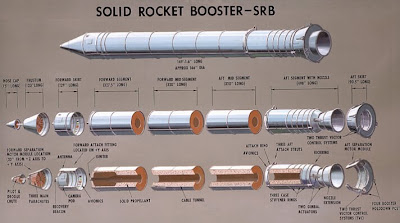Alert reader Caleigh Hadon of Los Angeles, CA sent me a link to a fascinating article about How the Romans Influenced the Space Shuttle. Seems even her high school history teacher was tickled at the journey From Chariots to Rocket Boosters. Clearly champions of consequential causality, they persuade us that the earliest style of spoke-wheeled carriers pulled behind beasts of burden set the standard from ancient times up through the current space program.
Chariot uniformity was no more complex than the span of two horses, side by side (about five feet). Roman roads were created to accommodate the vehicles of said width, which then spread millennially across Asia, Europe and the America. When roads turned into railroads, most tools had been "standardized" to such widths. Thus one choice, says the article, can have a huge impact on the world.

Is that a chariot? Hey, Romans had nice tans.
So when Romans built their roads of the width to accommodate chariots, all global roads and tunnels followed. When the space shuttle came along, its rocket boosters had to travel by train from their manufacturer to the launch pad. Thus, no matter how large or powerful NASA may have wanted them, they had to fit on flat train cars, and through standard-width train tunnels. And so the size of modern solid rocket boosters were determined by ancient Roman horse-drawn chariots.
Is this true?
Well... yes and no. Kudos to your skepticism, but please don't take any of this as a reason to argue with or be disrespectful to your teacher. Some of the greatest teachers I've ever had, whether or not I agreed with them, made me think, made me question, or piqued my interest to the point where I conducted my own analytical research. Sometimes, we just like believing stuff because it sounds cool. (But, you know, don't.)

Chances are, you will wear a white gown at your wedding. Roman brides did too. We still use plenty of things invented by the early Roman Republic and the later Roman Empire: candles, scissors, postage, showers, umbrellas, heating systems, street lights, and sadly, the tendency to live decadently beyond our means and tumble headlong into raging economic inflation.
So, to say that ancient standards are still alive in the modern world isn’t all that exciting. Humans are well-known for sticking with certain things that work, and equally notorious for sticking with certain things that don’t.
Archaeological evidence suggests the existence of chariots in far more ancient cultures: Chinese, Sumerian, Greek, Persian, etc. The Romans were late-comers, not inventors in this case, though they fancied-up chariot production with trigas (pulled behind three horses) and quidrigas (pulled behind four horses). So, while we can credit their empire with widespread road systems, they weren't overly attached to the simple metric of dual-equine-derriere, by any means.
Methods and means of transportation have, throughout history, been designed different ways to carry different things and accommodate many different vehicles. Some have been dictated by creation costs, others by limitations of nature. I've been to your city, and know you have everything from gravel roads to freeways that are 14 lanes across. In general on either of those two extremes, a single lane accommodates a car as small as a Mini or a truck with 18-wheels. Commonality of construction is no odder here than the idea that all automobiles have steering wheels – regardless of size, or number of doors.
The Romans would have called such specification: "desideratum" – colloquially, that which is essential is desired.

Good for you, Caleigh!
At the height of the railway era, over a hundred US companies manufactured three different gauges of track, showing a decided lack of standardization. The Chariot-to-Shuttle tale also assumes that any tunnel would only accommodate a single set of tracks, or only clear the train's mass with no room to spare. Also notice the tunnel in question is not mentioned by name –- but between where the boosters are built (Utah) and where they are ignited (Florida), there are probably fifty or more. We could sit and pick at this one all day, but the important thing is (and this warms my heart, coming from a high-schooler), you already know the rhythm of an urban legend when you hear one.
I'm sure NASA takes travel into account when designing hardware specifications, but to my knowledge, NASA has never been crippled by the slightly-less-than-five-foot span of railroad tracks. No less than 20 companies contribute to the many parts of solid rocket boosters, so even if transport was the main event, much of the hardware is already delivered in segments, and "Some Assembly Required" is already a given on the launch pad. :)


































































